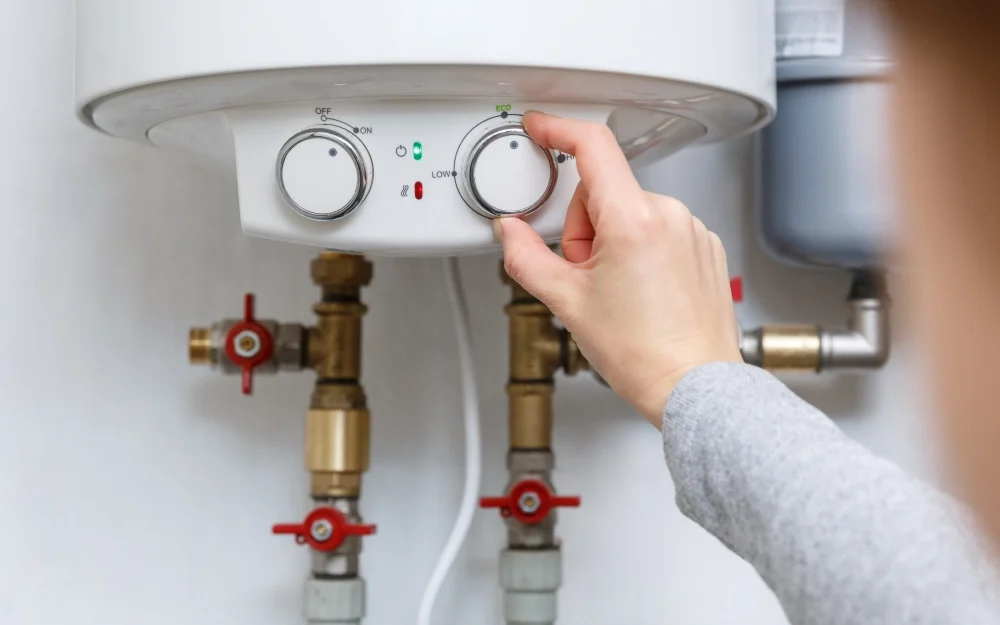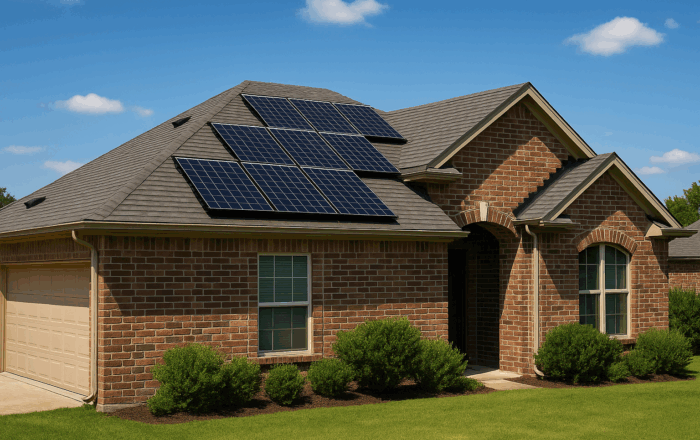Home Improvement Living in Texas
How Many Solar Panels Do You Need in Texas?
4 minute readHow to calculate the number of solar panels you need to power your Texas home
Home > BKV Energy Blog > All Posts > Tankless Water Heater Pros and Cons
5 minute read • Last update August 2024

A tankless water heater, also known as an on-demand or instant water heater, heats water only when needed. Unlike traditional storage tank heaters, which continuously heat and store water in a tank. In other words, tankless models provide as much hot water as your household requires without having to pay to keep a large tank of water hot all the time.
Whether a high-efficiency tankless water heater is the right choice depends on several factors. We’ll get into a complete list of pros and cons in just a moment. However, how much instant hot water your family needs will typically be a deciding factor. According to energy.gov, tankless water heater energy savings are between 24%–34% for small households using 41 gallons or less per day and 8%–14% for larger families that get through around 86 gallons per day.
Here’s a quick rundown of the different types of tankless hot water heaters available to you:
Tankless water heaters work by heating water on demand without storing it in a tank. When the hot water tap is turned on, cold water flows through the unit, where it is heated instantly by either a gas burner or an electric element. The heater’s sensors detect the water flow and activate the heating process, adjusting the power output to maintain the desired temperature. This allows for a continuous supply of hot water, as long as the demand does not exceed the unit’s capacity, making it more energy-efficient since it only heats water when needed, without the standby heat loss associated with traditional tank water heaters.
The primary benefits of a tankless water heater lie in energy, water, and space savings. Here’s a rundown of the primary factors to consider:
As you can see from the Energy Gov stats we mentioned earlier, you use much less fuel and electricity by only heating water as needed. Even if the saving is just 10%, that equates to a considerable amount over time.
Demand-type water heaters are a proven way to minimize hot water wastage. For environmentally conscious homeowners, this is a great way to step up your water conservation efforts.
Because they always provide hot water, you never need to worry about being stuck with only cold water and icy showers if you’re the last one up in the morning!
Tankless water heater installation takes up minimal space in your home compared to a traditional tank water heater. Tankless units can even be installed in tight spaces like closets or utility rooms.
Using less energy is one of the most effective ways to lower your energy bill. Even with rising or fluctuating energy costs, a minimum saving of just 8% could equate to around $200 a year based on the average electric bill in Texas.
Tank water heaters typically last only 10–15 years, whereas tankless versions usually last over 20. Plus, they have easily replaceable parts that may extend their lifespan even further. So, even if the initial investment is higher, the cost will likely be offset over time.
Tankless units avoid the standby heat losses associated with conventional storage tank models, which consistently use more energy — regardless of whether they’re in active use or not.
Many tankless water heaters have advanced thermostatic controls, allowing you to set and maintain precise temperatures. This is particularly helpful for households with young children or elderly members at risk of scalding.
Some tankless systems qualify for tax credits and rebates. For example, tankless gas water heaters with an ENERGY STAR certification and a UEF (Uniform Energy Factor) greater than 0.95 are eligible for tax credits of up to $600 or 30% of the project cost.
With such an extensive list of tankless water heater advantages, you may already be thinking it’s a no-brainer. However, there are some cons of tankless water systems to consider, too. Here’s a list of considerations:
The upfront cost of tankless water heaters tends to be higher than a standard storage water heater. Even though the long-term savings can be significant, this may be a drawback for many homeowners.
Installation requires a professional plumber and may involve modifications and upgrades to your existing gas and water lines or electrical system to handle the increased demand.
Routine maintenance is required to maintain efficiency and longevity. Proper maintenance on a tankless setup typically involves descaling, air filter replacement, and regular checks of the heating elements, condensing unit, etc.
While they provide an endless supply of hot water in theory, models that rely on electricity or natural gas won’t function during power outages. For gas models, in particular, any disruption in the gas supply can lead to a lack of hot water.
For homes with multiple showers, appliances, and fixtures that require hot water simultaneously, a single no-tank water heater may not be sufficient to provide enough heated water at all times. You can install multiple units, but this also increases installation costs and overall complexity.
While electric tankless water heaters are more straightforward to install, gas models require proper venting to remove exhaust gas and may involve installing additional stainless steel or PVC pipes.
Tankless units often require a higher gas flow rate or a larger electrical capacity than storage water heaters. Upgrading your existing system from a limited flow rate could significantly increase your tankless water heater installation cost.
The total tankless water heater cost varies depending on several factors, including the type of unit, fuel source, installation complexity, and ongoing maintenance costs:
Before making the switch to a tankless system, it’s essential to consider your investment from multiple angles. Here are the steps to ensure you make the right decision:
We hope you’ve found our analysis of tankless water heater pros and cons helpful in making your decision. Whatever system you decide on, choosing the right electricity plan can enhance your energy and energy bill savings even further.
At BKVE, we offer straightforward homeowner electricity plans tailored to your household’s needs and preferences. Simply enter your zip code to learn more and find the right plan for you.
Graham Lumley, Digital Marketing Manager at BKV Energy, leads digital and traditional marketing strategies, focusing on educating Texans about the state's deregulated energy market. With over 8 years of marketing experience, he creates content to help consumers understand and save on their energy bills, bringing a fresh and dynamic approach to the industry.

Home Improvement Living in Texas
How to calculate the number of solar panels you need to power your Texas home

Gardening in Texas presents unique challenges. Long, hot summers and frequent droughts mean that traditional landscaping often requires significant water
Get $50 off your electric bill!
Use code BKVEJOINUS50
Enter your zip code to shop BKV Energy's affordable, fixed-rate Texas electricity plans. Use the promo code for $50 off your electric bill.